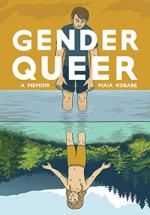|
This section contains 830 words (approx. 3 pages at 400 words per page) |

|
Gender Queer: A Memoir Summary & Study Guide Description
Gender Queer: A Memoir Summary & Study Guide includes comprehensive information and analysis to help you understand the book. This study guide contains the following sections:
This detailed literature summary also contains Topics for Discussion on Gender Queer: A Memoir by Maia Kobabe.
The following version of this book was used to create this study guide: Kobabe, Maia. Gender Queer: A Memoir. Portland: Oni-Lion Forge Publishing Group, 2020.
The memoir begins with a brief introduction, in which Kobabe writes of attending graduate school for art and taking an autobiography class. The teacher suggested the students write about their “biggest secrets” (5). Kobabe wrote about eir gender identity but taped paper over those pages in eir sketchbook because e was embarrassed.
Kobabe then begins with eir childhood. E grew up in Northern California with hippie parents, a younger sister, and a neighbor best friend named Galen. When Galen and Kobabe started kindergarten, e had eir first experiences with gender roles and expectations, as these kinds of beliefs were not reinforced in eir home. E recalls being excluded from a clubhouse because e was a “girl” (17) and being asked to put eir shirt back on at a school field trip to the beach. At age 11, Kobabe began menstruating. E found this to be an upsetting experience, and e still has nightmares about it. E began wearing a bra, and wished e would develop breast cancer so e would have to get a mastectomy.
By high school, Kobabe realized e might be queer. E was attracted in particular to a masculine-looking girl in eir class, but also fantasized about sex between two men. The only openly gay student at eir school, David, started a Queer Straight Alliance club and Kobabe joined, feeling pleased to meet other students who were queer and/or allies. E was uncertain as to how to define eir sexuality because e was also confused about eir gender identity. E wondered if e was a lesbian, or perhaps “a gay boy trapped in a girl's body” (65). In a journal entry from this period, e wrote, “I don't want to be a girl. I don't want to be a boy either. I just want to be myself.”
At age 16, Kobabe had eir hair cut short in a salon. E did not like the feminine style the hairdresser gave em, so e had eir sister Phoebe cut it differently. Phoebe is also queer and has long been supportive of Kobabe's sexuality and gender identity. Just before high school graduation, Kobabe was asked out on a date by a male classmate. E agreed, but then backed out after the boy referred to em as his girlfriend. E recalls thinking, “I will NEVER be anyone's girlfriend” (91). E came out to eir mother as bisexual and she was supportive.
Kobabe went to art school for eir undergraduate degree and got a job at the school library. One day, a female classmate named Autumn came into the library and one of Kobabe's coworkers told em that she had a crush on em. Embarrassed, Kobabe fled, but later contacted the girl on Facebook. E considered dating the girl just to understand what dating was like, but ultimately decided not to. On pages 120-1, Kobabe has drawn a scale, which e uses as a metaphor for eir gender identity. One side is weighed down with a large weight reading “ASSIGNED FEMALE AT BIRTH” (120), while Kobabe is adding weights to the other side reading “SHORT HAIR” and “BAGGY BOY CLOTHES” (121). E does not want to appear more masculine, only to appear less feminine to balance the scale after being assigned female at birth.
While getting eir first gynecological pap smear exam, Kobabe experienced extreme physical and psychological pain — gender dysphoria related to being reminded of eir assigned-at-birth gender. E told eir mother that e was gender queer, and she was supportive but confused, telling Kobabe, “You don't have to be super-feminine to be a woman” (148). She did not understand that Kobabe did not identify as a woman at all.
Kobabe started graduate school and began writing fan fiction about the boy band One Direction. E wanted some dating experience to write more realistic stories, so e downloaded a dating app and met a woman named Z, whom e dated and had eir first sexual experiences with. E broke up with Z upon realizing that e needed to better understand eir gender before having a romantic relationship.
Kobabe met an old family friend named Jaina Bee, who told em that e was nonbinary and using the Spivak pronouns (e/em/eir). Kobabe liked these pronouns and decided to start using them emself. E told eir family and friends about eir new pronouns and people were very receptive, though they made mistakes.
E suffered through another gynecological exam, this time telling the doctor beforehand about eir gender dysphoria. The doctor prescribed anxiety and pain medication to help Kobabe through the experience.
Kobabe began teaching a class on comics to junior high students. E was uncertain if e should tell them that e was nonbinary, but ultimately decided to do so. Since e did not know any nonbinary people growing up, e understood the importance of being a figure of representation to a younger generation.
Read more from the Study Guide
|
This section contains 830 words (approx. 3 pages at 400 words per page) |

|



